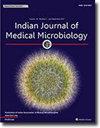Fasciolopsis buski isolated from human host, India has distinct clade based on nuclear ribosomal DNA sequences
IF 1.4
4区 医学
Q4 IMMUNOLOGY
引用次数: 0
Abstract
Fasciolopsiasis caused by Fasciolopsis buski, is a significant cause of morbidity. In the present study F. buski detected during endoscopy of a 50-year-old male patient form Uttar Pradesh, India was used for phylogenetic analysis based on 28S rDNA and ITS2 regions. The parasite was genetically similar to an isolate of pig from Meghalaya. The intra-species genetic variation for 28S rDNA was 1–3% (India), 5% (Vietnam) and for ITS2, 1–2% (India) while 17 % from Vietnam. Thus, F. buski from humans or pigs from India were closely related than those from Vietnam and China which were grouped into separate clades.

根据核核糖体 DNA 序列,从印度人类宿主中分离出的 Fasciolopsis buski 具有独特的支系。
由 Fasciolopsis buski 引起的鱼鳞病是发病的一个重要原因。本研究根据 28S rDNA 和 ITS2 区域对在印度北方邦一名 50 岁男性患者的内窥镜检查中检测到的 F. buski 进行了系统发育分析。该寄生虫在遗传学上与梅加拉亚邦的猪分离株相似。28S rDNA 的种内遗传变异为 1-3%(印度)和 5%(越南),ITS2 的种内遗传变异为 1-2%(印度)和 17%(越南)。因此,与越南和中国的F. buski相比,印度的人或猪与F. buski的亲缘关系更为密切,而越南和中国的F. buski则被划分为不同的支系。
本文章由计算机程序翻译,如有差异,请以英文原文为准。
求助全文
约1分钟内获得全文
求助全文
来源期刊

Indian Journal of Medical Microbiology
IMMUNOLOGY-
CiteScore
2.20
自引率
0.00%
发文量
154
审稿时长
73 days
期刊介绍:
Manuscripts of high standard in the form of original research, multicentric studies, meta analysis, are accepted. Current reports can be submitted as brief communications. Case reports must include review of current literature, clinical details, outcome and follow up. Letters to the editor must be a comment on or pertain to a manuscript already published in the IJMM or in relation to preliminary communication of a larger study.
Review articles, Special Articles or Guest Editorials are accepted on invitation.
 求助内容:
求助内容: 应助结果提醒方式:
应助结果提醒方式:


